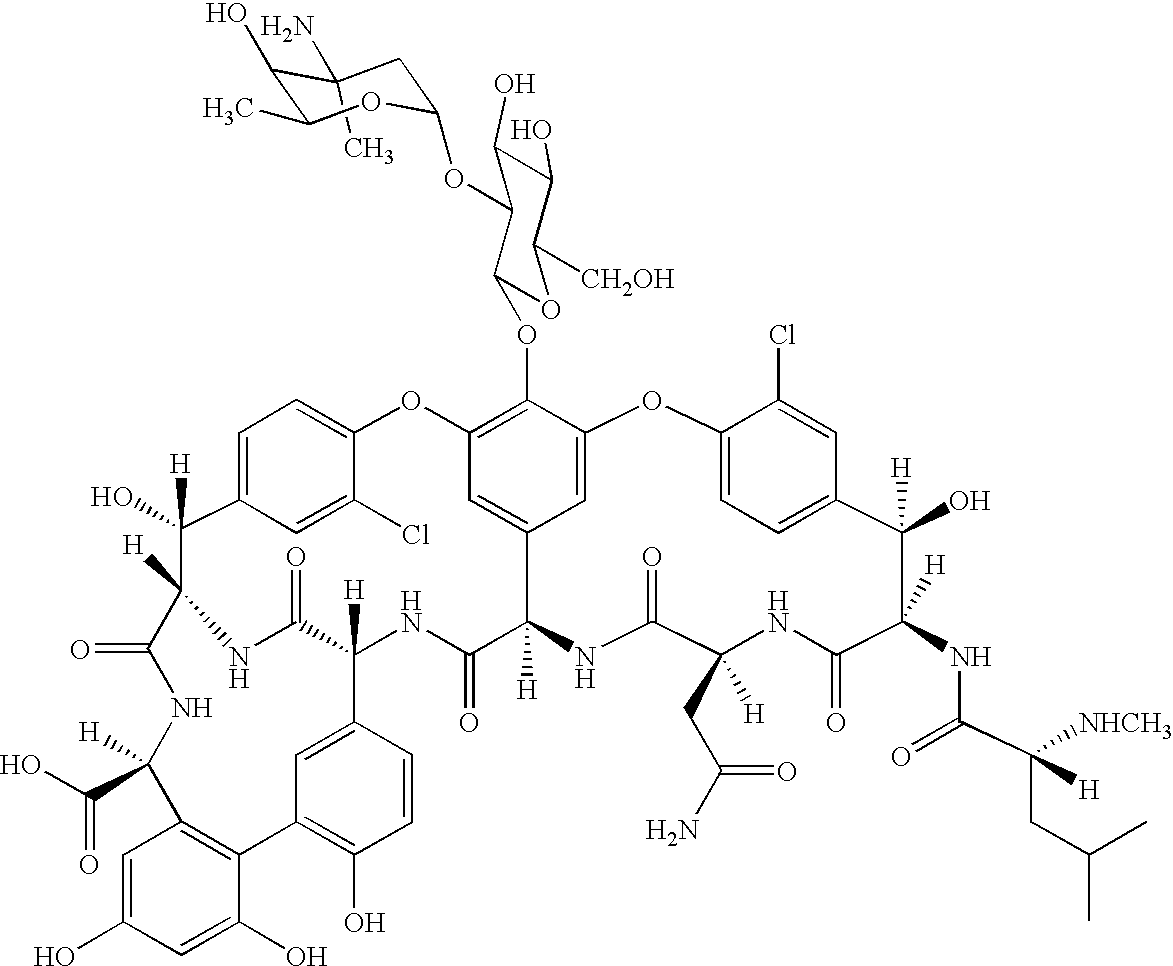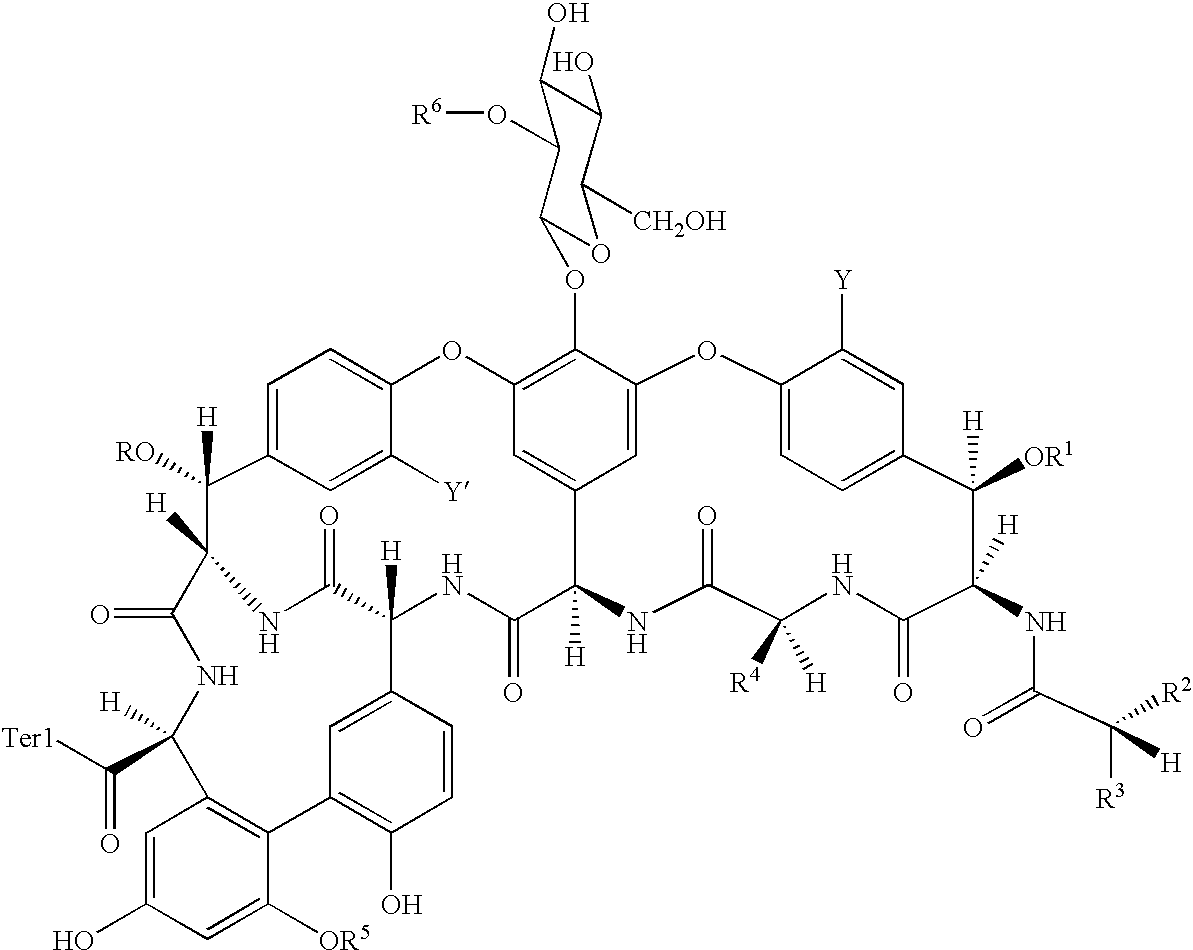Antibacterial agents comprising conjugates of glycopeptides and peptidic membrane associating elements
a technology of glycopeptides and conjugates, which is applied in the direction of peptides, cyclic peptide ingredients, drug compositions, etc., can solve the problems of bacterial infections that cause significant morbidity and mortality in man and other mammals, reorganization of membrane structures, and creation of pores through which intracellular contents may leak, etc., to achieve strong binding and higher proportion
- Summary
- Abstract
- Description
- Claims
- Application Information
AI Technical Summary
Benefits of technology
Problems solved by technology
Method used
Image
Examples
example 1
Synthesis and Characterisation of APT542
[0177](MSWP-1, Example 2 of WO / 9802454). The peptide: Gly-Ser-Ser-Lys-Ser-Pro-Ser-Lys-Lys-Lys-Lys-Lys-Lys-Pro-Gly-Asp-Cys-NH2 (SEQ ID NO:1) was prepared using solid phase synthesis via the general Fmoc / tBu strategy developed by Sheppard and Atherton (E. Atherton and R. C. Sheppard, Solid Phase Synthesis, IRL Press, Oxford, 1989). Kieselguhr-supported polydimethylacrylamide resin (Macrosorb 100) was used as the solid support and was derivatised with ethylene diamine.
[0178]Coupling reactions were carried out using N-α-Fmoc protected reagents pre-activated with N,N′-diisopropylcarbodiimide / N-hydroxybenzotriazole (in 4-fold molar excess) with bromophenol blue monitoring. Fmoc Cleavages used 20% piperidine in DMF. Reactions to assemble the peptide chain were carried out by repeated cycles of coupling and deprotection including the attachment of the modified Rink linkage reagent (p-[(R,S)-α-[1-(9H-fluoreny-9-yl-methoxyformamido]-2,4 dimethoxybenzyl]...
example 2
Synthesis and Characterisation of APT540
[0182]APT540 is a dimer of APT542, linked via a cysteine bridge through the C-terminal cys residues.
[0183]APT542 (Example 1; Example 2 in WO 98 / 02454; 54 mg) was dissolved in 0.1 M Tris pH 8.5 (2.68 mL) and treated with 0.35 molar equivalents of tris-2-carboxyethyl phosphine (TCEP) dissolved in water. The reaction was allowed to proceed for 30 minutes at room temperature and analysed by HPLC using a C18 reverse phase column with a gradient of 35%–90% acetonitrile in 0.1% trifluoroacetic acid. Reaction products were monitored at wavelengths of 210 nm and 310 nm. APT540 was identified as a peak eluting from the column at approximately 10.5 minutes after injection. The material corresponding to the APT540 compound was collected and lyophilised. Mass spectrometry of this sample using a PerSeptive Biosystems instrument identified a major peak of 3998 daltons which corresponds to the theoretical molecular weight of APT540. APT540 was tested for anti...
example 3
Synthesis and Characterization of APT541
[0184]APT541 is an N-myristoyl derivative of SEQ ID NO:1, which is further derivatised at its C-terminus by the addition of a cysteine residue on the side chain of the C-terminal cysteine.
[0185]APT542 (Example 1; 10 mM in 100 mM Tris pH 8.5; 1.3 mL) was mixed with 100 mM cysteine (0.1 mL) and stirred over 2 h. The reaction mixture was purified by preparative HPLC using a gradient of 0–100 % acetonitrile in 0.1% trifluoroacetic acid over 10 minutes. The product eluted at approximately 10.0 minutes, and was collected. Evaporation of volatiles and lyophilisation afforded APT541 as a white solid. MALDI TOF Mass Spec. C92H168N26O26S2 requires: 2117.2 Da. Found: 2117.3 Da. When purified APT541 was treated with excess 1 mM DTT, no increase in absorbance at 343 nm was observed which indicated that all thiopyridyl groups had been replaced.
[0186]The antibacterial activity of APT541 was also determined against E. faecium STR 207, E. faecalis V 583, E. fa...
PUM
| Property | Measurement | Unit |
|---|---|---|
| molecular mass | aaaaa | aaaaa |
| minimum inhibitory concentration | aaaaa | aaaaa |
| molecular weight | aaaaa | aaaaa |
Abstract
Description
Claims
Application Information
 Login to View More
Login to View More - R&D
- Intellectual Property
- Life Sciences
- Materials
- Tech Scout
- Unparalleled Data Quality
- Higher Quality Content
- 60% Fewer Hallucinations
Browse by: Latest US Patents, China's latest patents, Technical Efficacy Thesaurus, Application Domain, Technology Topic, Popular Technical Reports.
© 2025 PatSnap. All rights reserved.Legal|Privacy policy|Modern Slavery Act Transparency Statement|Sitemap|About US| Contact US: help@patsnap.com



